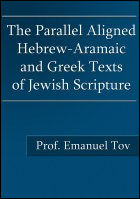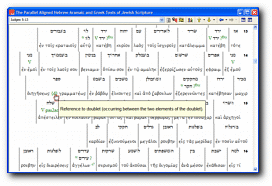 The
Parallel Aligned Hebrew-Aramaic and Greek Texts of Jewish Scripture by Prof.
Emanuel Tov
The
Parallel Aligned Hebrew-Aramaic and Greek Texts of Jewish Scripture by Prof.
Emanuel TovThe Parallel Aligned Hebrew-Aramaic and Greek
Texts of Jewish Scripture by Prof. Emanuel Tov uses the latest
interlinear display features of Libronix Digital Library System to align the
Masoretic text of the Hebrew Bible/Old Testament with the Septuagint, the
ancient Greek translation of the Hebrew Bible (nick-named LXX, due to a
legend about its origin).
The Septuagint has always been one of the most important texts for Old
Testament text critical study, as it is the earliest known translation of
the Hebrew Bible. Because the Septuagint was translated well before the
Masoretic text (the Hebrew text used today) was firmly established, it often
retains variant readings not extant in the Hebrew sources. The Septuagint is
of special interest to New Testament scholars as well, as the Septuagint was
the version of the Old Testament most widely used in the early church.
Quotations of, and allusions to, Hebrew Scripture within the New Testament
itself often match the Septuagint, or are 'mixed' between the Septuagint and
the Masoretic readings.
About
Prof. Tov's Parallel shows how the Hebrew and Aramaic line up
against the Greek text on a word-by-word basis, but it does far more. In
places where the Greek text doesn't follow the Masoretic reading, Dr. Tov
has provided a reconstruction of what the Hebrew or Aramaic text that the
Greek translators were looking at might have been. In addition to these
theoretical reconstructions, this database includes copious notes on the
translation techniques used by the Septuagint translators, making this work
a rather specialized commentary on the text. Did the Greek translators
change the word order for grammatical or stylistic reasons? Did they change
the voice of a verb from passive to active? Did they use a genitive absolute
to translate an infinitive absolute? These types of observations are
exhaustively noted in the alignment.
Prof. Tov, of Hebrew University in Jerusalem, has written extensively on the
Hebrew Bible, text criticism, the Septuagint, and the Dead Sea Scrolls.
Students of Greek and Hebrew, text criticism, the history of the Bible, and
the New Testament use of the Old Testament will all benefit greatly from
Prof. Tov's diligent scholarship in The Parallel Aligned Hebrew-Aramaic and
Greek Texts of Jewish Scripture.
'The fundamental document of Hellenistic Judaism is the Greek translation
of the Old Testament, commonly known as the Septuagint, which was made, to
speak broadly, during the three centuries preceding the Christian Era.
Translation is an impossible art, for the words of one language seldom or
never convey precisely the same ideas as the corresponding words of another
language. Besides philological differences in the words themselves, there
are differences in the associations which the words have acquired in
different contexts of thought and experience. Thus the words of the Hebrew
Scriptures, in passing into Greek, partly lost one set of associations, and
partly gained a new set, while at the same time the Greek words used in
translation may have acquired something of the value of the Hebrew words
they represent. If we can recover in some measure the associations of the
Greek words, and compare them with the associations of the Hebrew words, we
may do something towards fixing the meaning which the words would henceforth
bear in Hellensitic Judaism, and wherever the influence of Hellenistic
Judaism extended.'
-Dodd, C.H., The Bible and the Greeks (London:Hodder &
Stoughton) 1935, pp. xi-xii.
Sample Screenshot
For the full size version, click the image below.

| Стоимость CD-ROM: 10 у.е. |


